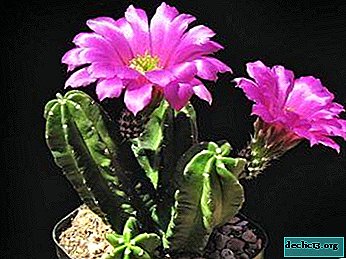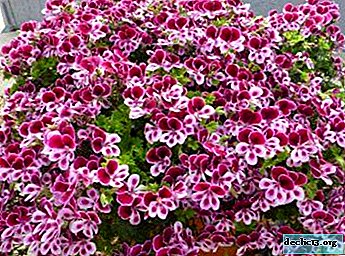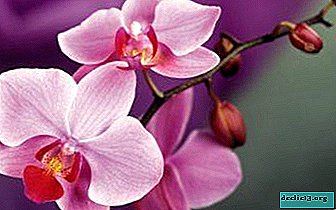Bright beauty rose Nina Weibul - characteristics of the variety, care tips and photos of the plant
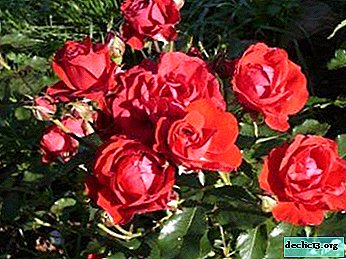
Rosa is the world-recognized queen of gardens, flower beds and greenhouses. A diverse range of colors, many different forms of buds, long flowering periods - all this makes the rose the most popular decorative plant among other representatives of the colorful flower world.
More often than other varieties, Nina floribunda rose is found in gardens and home gardens, since even a beginner gardener can take care of a flower.
In the article, we consider a botanical description, the history of occurrence, we learn how it differs from other varieties, we study the care instructions.
Botanical Description
This variety is a branched neat bush with dark green leaves. Bright red buds collected in brushes of 3-4 pcs. cover the ornamental plant until late autumn, and crumble with the onset of frost. The culture reaches a height of 90 cm, the bush branches up to 0.5 m wide. This variety of roses is suitable for mass planting in large areas.
The following factors are the benefits of Nina cultivation:
- Flower immunity of diseases of fungal origin: black spotting and powdery mildew.
- Continuous flowering throughout the season.
- Resistance to frost.
- Ease of care.
Unpretentiousness to watering and resistance to external natural factors have made this variety popular among experienced and novice gardeners. There are some disadvantages that a queen of all colors can face:
- The stems of the plant are dotted with strong sharp spikes that interfere with the comfortable care of the rose.
- The delightful aroma inherent in this type of ornamental plants is absent.
Photo
The photo shows a rose variety called Nina Weibul.




History of occurrence
When crossing the polyanthus, musk and tea-hybrid roses, an amazing plant was obtained, adapted to a frosty winter, abundantly blooming with scarlet buds and not requiring special skills and knowledge when growing.
For the first time, the ancestors of the modern floribunda rose were presented to the eyes of gardeners in 1903 by Peter Lambert. Work on the development of new varieties continues to date.. In the class of floribunda, they began to include specimens obtained as a result of breeding that have similar characteristics to polyanth and tea-hybrid cultures. One of the results of breeding work was the variety Nina Weibul.
What are the differences from the other varieties?
A distinctive feature of this representative of the class of floribunda is endurance, resistance to damage by various types of fungus, the ability to grow flowers in open ground in regions with severe climatic conditions. The variety Nina Weibul is very popular in the countries of Scandinavia, Finland and Iceland.
Bloom
 Bushes of floribunda Nina Weibel bloom all season, and with proper care, some inflorescences are replaced by others before the onset of frost.
Bushes of floribunda Nina Weibel bloom all season, and with proper care, some inflorescences are replaced by others before the onset of frost.
- The first buds appear on the bushes by mid-June, after which continuous flowering continues until November.
- To this variety of roses every year to please the owners with a large number of inflorescences, before flowering, you need to feed the bushes with sodium humate in a proportion of 1 tbsp. spoon to 40-50 liters of water. Under each bush you need to pour 2 liters of such a solution. At the end of the flowering of the rose, fertilizers with a high concentration of trace elements must be fed and pruned.
- If the rose Nina Weibul does not want to bloom, urgently need to analyze the conditions of the flower, find out the reasons for the lack of buds and work on the mistakes.
- Floribunda Nina grows well and blooms on loamy soil; soil acidity should not exceed 7pH.
- If the bush suffered from winter frosts, then in the current season, stems and green leaves will grow, and flowers will appear next year, subject to a successful wintering.
- After flowering, you need to trim the branches with faded buds so that the plant does not spend on them the forces necessary for the formation of new inflorescences.
Reference. After transplanting, the rose bush undergoes adaptation and during this period the buds do not form.
- Roses Nina Weibul look great when designing rose gardens and designing garden plots. The medium-sized bushes of the Nina rose are strewn with large scarlet buds for a whole season. The flowering of the bush is continuous and the group of roses looks great against the background of undersized juniper varieties. Nina floribunda flowers retain the brightness of colors and do not fade in the sun.
Care instructions
Floribunda Nina - one of the most undemanding care varietiesbut in order for the bushes to bloom continuously until late autumn, you need to know how to properly care for them.
Choosing a place to grow
Proper planting will provide the bush with the correct development and formation of a large number of buds.
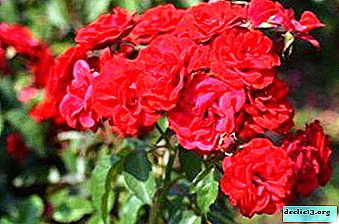 When choosing a place for a rose, Nina Weibul needs to consider that this variety, like all roses, loves a lot of light. The amount of sunlight is an important factor that will ensure continuous flowering of the bush.
When choosing a place for a rose, Nina Weibul needs to consider that this variety, like all roses, loves a lot of light. The amount of sunlight is an important factor that will ensure continuous flowering of the bush.- The place where the rose will grow must be protected from winds and drafts.
- No need to plant a bush in the shade of trees, because in addition to sunlight, they will take away nutrients from the flower.
- It is better to choose a place even or slightly hilly, since there is a danger of winds on the hills, and a large amount of moisture accumulates in the lowland and water stagnation forms.
- The place where roses used to grow for 8-10 years is not suitable for planting.
The soil
Land for roses of this variety must be well-drained. Avoid soil with a high salt content or very wetlands. The ideal option would be a slightly acidic, well-fertilized earth or chernozem. Soil acidity can be reduced by adding ash or lime, and increased by peat and manure.
Seed planting
Planting Nina's roses with seeds is an interesting activity, but not the easiest.
- The ripened fruits must be cut into halves and the seeds cleaned of pulp, which will prevent germination.
- The cleaned seeds must be decontaminated by treating them with hydrogen peroxide.
- Take 2 cotton pads soaked in hydrogen peroxide and place rose seeds between them. Then place the discs in a bag to avoid the rapid evaporation of hydrogen peroxide. On the bag write the name of the variety from which the seeds were collected.
- To place bags of seeds in the container of the refrigerator intended for storage of vegetables.
- Periodically, you need to check the seeds; if mold appears, remove damaged specimens and change cotton pads.
- 45-60 days after seed placement, tiny sprouts hatch.
- Sprouted seeds to plant in individual pots.
- To get strong plants, you need to provide the sprouts with 10 hours of lighting.
From the moment of planting the germinated seed to receive a small bush, 2-3 months pass.
Temperature
Nina Weibul is a frost-resistant variety, but these bushes grow best at a temperature of +10 - +18 o. The heat of the rose is not tolerated well, and in winter frosts, plants need to be well covered.
Watering
 To provide the bush with magnificent bloom, it must be properly watered.
To provide the bush with magnificent bloom, it must be properly watered.
- Hot weather and strong winds dry the soil faster than usual. In such periods, watering is carried out every day.
- In normal weather, Nina's roses are watered once every 4-7 days.
- Recently transplanted bushes need more frequent and plentiful watering, as their root system is poorly developed.
It is better to fill the rose with a large amount of water 1 time than a little and often.
Top dressing
In order for luxurious bushes to decorate the garden for a long time and not cause trouble, you need to feed them in a timely manner.
- The first feeding with ammonium nitrate is carried out 10 days after spring pruning before the leaves bloom.
- With the same fertilizer, you need to feed the bushes at the time of bud formation.
- Before flowering, you can add organic fertilizer. Mullein, diluted in a proportion of 1:10, is suitable.
Before winter, superphosphate and potassium salt can be added to each bush.
Pruning
Pruning Nina roses is designed to provide continuous flowering:
- Before planting a bush, you need to remove weak branches and dried roots.
- Spring pruning is reduced to shortening the main stems by 4-5 buds, the distance from the base to the place of cut should be 20 cm.
- Weak side branches need to be removed. The formation of new stems begins in mid-May.
- Adult bushes begin to prune at the end of March, pruning new shoots by a third.
- In the autumn after flowering, you need to pinch all the main stems, cut off all the green shoots and peduncles.
Transfer
Transplantation of the queen of the garden plot of Nina Weibul is made from mid-April to mid-May. In the prepared spacious pit, you need to move the bush with a large earthen lump. After transplanting, you need to leave 3 leaves on each shoot, trim the rest. You need to remove the shoots that grow inside the bush. Maximum efforts during the transplantation of Floribunda Nina should be aimed at maintaining the integrity of the roots.
Preparation for winter
 Before winter shelter, rose bushes need to be pruned and the soil thoroughly loosened.
Before winter shelter, rose bushes need to be pruned and the soil thoroughly loosened.
- Watering must be stopped from mid-September.
- To increase the resistance of roses to frost, in the fall you need to make potash fertilizers.
- Trim immature shoots, leaves and buds.
- The roses begin after steady cold weather.
- Sprinkle the earth around the bush with a layer of ash.
- Pour dry earth or peat at 1/3 of the height of the plant.
- After that, cover the roses with spruce pine or spruce. Such a coating will protect the bushes from wind and moisture.
Breeding
The most popular way of breeding roses of this variety remains cuttings.
- From adult shaped shoots, cuttings 10 cm long must be cut.
- The lower cut should be done at an angle, and the upper perpendicular to the trunk.
- All green leaves and thorns must be removed.
- Treat the bottom of the cuttings with root.
- The interval between plantings is 20 cm.
- Cover the planted cuttings with a film with supports so that the shelter does not touch the tops of the cuttings.
From time to time you need to remove the film for ventilation and watering.
Diseases and Pests
Nina floribunda variety is resistant to many fungal diseasesbut with improper care, the plant is affected by some diseases.
- Black spotting occurs in the second half of summer due to excess air humidity.
- Rust affects young leaves and shoots in early spring and spreads with high humidity.
- Powdery mildew roses suffer if the weather is cool and humid for a long time.
From rust and black spotting will help spraying with mullein infusion, decoction of field horsetail or nettle. Powdery mildew does not like ash treatment.
With proper care, the rose Nina Weibul rarely gets sick, lives long and pleases with stunning flowers.

 When choosing a place for a rose, Nina Weibul needs to consider that this variety, like all roses, loves a lot of light. The amount of sunlight is an important factor that will ensure continuous flowering of the bush.
When choosing a place for a rose, Nina Weibul needs to consider that this variety, like all roses, loves a lot of light. The amount of sunlight is an important factor that will ensure continuous flowering of the bush.
